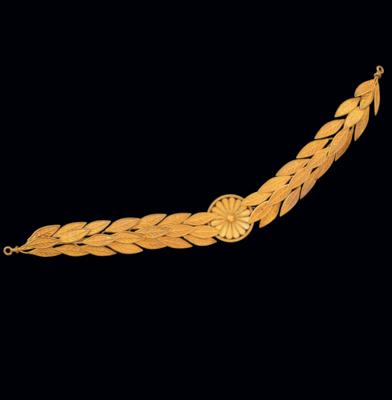A bandeau diadem by Castellani, from an old European aristocratic collection
gold 750, partly pure gold coloured, length c. 18 cm, workmanship c. 1860, signed, 38.4 g, case, partly stained
The Italian goldsmith dynasty Castellani played a pivotal role in the revival of antique goldsmithing in 19th-century Rome. Inspired by the spectacular discovery of the Etruscan tomb in the Campana Collection, the Castellani workshop developed innovative goldsmithing techniques in an archaeological style.
Fortunato Pio Castellani laid the foundations of the company in 1814 and opened the first store on Via del Corso in Rome. His sons, Alessandro and Augusto, perpetuated the legacy of the company founder, facilitating the company’s further expansion and enhanced reputation.
In 1860, Alessandro Castellani relocated to Paris, where he was able to expand his clientele to include influential aristocratic and industrial families. This helped the Castellani name to gain a great reputation. He later settled in Naples.
The present diadem embodies Castellani’s antique style. The delicate leaves form a subtle head jewel in the shape of a gold laurel wreath. Archaeological finds of similar jewellery from the Campana collection can be found in the Hermitage Museum in St. Petersburg.1 A similarly executed diadem is preserved in the Museo Nazionale Etrusco di Villa Giulia in Rome.2 On the reverse is the signet CC for Castellani.
A laurel diadem appears in the inventory list of the store in Rome on 1 July 1862 in combination with the name Alessandro.3 A preparatory sketch can be found in the Museo d'Arte Industriale di Roma.4
The later box labelled ‘Perez Naples’ suggests that it was purchased in the Naples area.
1 Tresor antiques, Bijoux de la collection Campana, Musée du Louvre, Exposition 21 Oct 2005 - 16 Jan. 2006, pp. 103-107
2 Tresor antiques, Bijoux de la collection Campana, Musée du Louvre, Exposition 21 Oct 2005 - 16 Jan. 2006, pp. 104-105
3 Archivio di stato di Roma, Fondo Famiglia Castellani, Registro 98, Diadema lauro ed ellera 35 = 50 (Alessandro)
4 Tresor antique, Bijoux de la collection Campana, Musée du Louvre, Exposition 21 Oct 2005 - 16 Jan. 2006, p. 105
Esperta: Mag. Beate Schlöglhofer
 Mag. Beate Schlöglhofer
Mag. Beate Schlöglhofer
+43-1-515 60-336
beate.schloeglhofer@dorotheum.at
23.05.2024 - 13:00
- Prezzo realizzato: **
-
EUR 33.800,-
- Stima:
-
EUR 7.000,- a EUR 10.000,-
A bandeau diadem by Castellani, from an old European aristocratic collection
gold 750, partly pure gold coloured, length c. 18 cm, workmanship c. 1860, signed, 38.4 g, case, partly stained
The Italian goldsmith dynasty Castellani played a pivotal role in the revival of antique goldsmithing in 19th-century Rome. Inspired by the spectacular discovery of the Etruscan tomb in the Campana Collection, the Castellani workshop developed innovative goldsmithing techniques in an archaeological style.
Fortunato Pio Castellani laid the foundations of the company in 1814 and opened the first store on Via del Corso in Rome. His sons, Alessandro and Augusto, perpetuated the legacy of the company founder, facilitating the company’s further expansion and enhanced reputation.
In 1860, Alessandro Castellani relocated to Paris, where he was able to expand his clientele to include influential aristocratic and industrial families. This helped the Castellani name to gain a great reputation. He later settled in Naples.
The present diadem embodies Castellani’s antique style. The delicate leaves form a subtle head jewel in the shape of a gold laurel wreath. Archaeological finds of similar jewellery from the Campana collection can be found in the Hermitage Museum in St. Petersburg.1 A similarly executed diadem is preserved in the Museo Nazionale Etrusco di Villa Giulia in Rome.2 On the reverse is the signet CC for Castellani.
A laurel diadem appears in the inventory list of the store in Rome on 1 July 1862 in combination with the name Alessandro.3 A preparatory sketch can be found in the Museo d'Arte Industriale di Roma.4
The later box labelled ‘Perez Naples’ suggests that it was purchased in the Naples area.
1 Tresor antiques, Bijoux de la collection Campana, Musée du Louvre, Exposition 21 Oct 2005 - 16 Jan. 2006, pp. 103-107
2 Tresor antiques, Bijoux de la collection Campana, Musée du Louvre, Exposition 21 Oct 2005 - 16 Jan. 2006, pp. 104-105
3 Archivio di stato di Roma, Fondo Famiglia Castellani, Registro 98, Diadema lauro ed ellera 35 = 50 (Alessandro)
4 Tresor antique, Bijoux de la collection Campana, Musée du Louvre, Exposition 21 Oct 2005 - 16 Jan. 2006, p. 105
Esperta: Mag. Beate Schlöglhofer
 Mag. Beate Schlöglhofer
Mag. Beate Schlöglhofer
+43-1-515 60-336
beate.schloeglhofer@dorotheum.at
|
Hotline dell'acquirente
lun-ven: 10.00 - 17.00
kundendienst@dorotheum.at +43 1 515 60 200 |
| Asta: | Gioielli scelti |
| Tipo d'asta: | Asta in sala con Live Bidding |
| Data: | 23.05.2024 - 13:00 |
| Luogo dell'asta: | Wien | Palais Dorotheum |
| Esposizione: | 27.04. - 22.05.2024 |
** Prezzo d’acquisto comprensivo dei diritti d’asta acquirente e IVA
Non è più possibile effettuare un ordine di acquisto su Internet. L'asta è in preparazione o è già stata eseguita.

